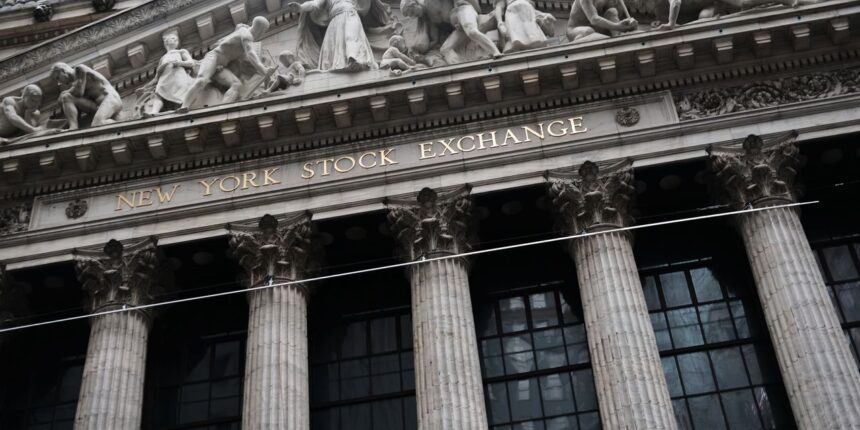U.S. stock indexes were edging lower on Wednesday morning after a sharp sell-off on Tuesday wiped away the Dow Jones Industrial Average’s 2023 gains as Treasury yields jumped to fresh 16-year highs in the previous session.
How are stock indexes trading
-
The S&P 500 index
SPX
shed 5 points, or 0.1%, to 4,224 -
The Dow Jones Industrial Average
DJIA
lost 102 points, or 0.3%, to 32,903 -
The Nasdaq Composite
COMP
gained 45 points, or 0.4%, to 13,101
On Tuesday, the Dow industrials fell 431 points, or 1.29%, to 33,002, posting its biggest daily percentage drop since the March banking crisis and its lowest closing level since May 31, according to Dow Jones Market Data. The S&P 500 declined by 1.4%, to 4,229, while the Nasdaq dropped 1.9%.
What’s driving markets
U.S. stock indexes were bouncing around on Wednesday morning as Treasury yields retreated after payroll processor ADP said U.S. private-sector employment rose by a tepid 89,000 in September. That was the smallest increase in two and a half years. Economists polled by the Wall Street Journal had forecast a gain of 150,000.
See: ADP says only 89,000 private jobs were created in September. That’s way below forecast.
Jeffrey J. Roach, chief economist at LPL Financial, said investors should treat the ADP report with caution as it does not include government workers and is not a “consistent indicator” of the official employment report that follows a few days later.
“That said, momentum within the labor market is slowing across the board in both goods-producing and services-producing businesses,” Roach said in emailed commentary on Wednesday.
“The labor market is cooling and is taking pressure off the Fed concerned with the risk of a second wave of inflation. Businesses should get some respite as inflation decelerates and the labor market comes into balance,” he added.
Meanwhile, an Institute for Supply Management (ISM) barometer of business conditions at service-oriented companies such as retailers and health-care providers fell slightly in September to 53.6 from 54.5 in the previous month, and indicated some softening in the U.S. economy. A reading above 50 indicates growth in the services industry. The reading matched the forecast of economists polled by The Wall Street Journal.
Weakness in U.S. stocks on Wednesday was led by the energy sector after crude oil prices fell to their lowest intraday level in four weeks. The S&P 500 Energy Sector was down 3.08% and has fallen for four consecutive days.
See: Rising Treasury yields are upsetting financial markets. Here’s why.
U.S. bond yields eased lower on Wednesday after hitting fresh 16-year highs in the previous session. The yield on the 2-year Treasury
BX:TMUBMUSD02Y
slipped by 6 basis points to 5.084%, while the yield on the 10-year Treasury
BX:TMUBMUSD10Y
dropped 5 basis points to 4.749%.
The choppiness came after the S&P 500 shed 1.4% on Tuesday to close at its lowest level since the start of June as investors balked at the sight of benchmark borrowing costs hitting fresh 16-year highs in a reflection of concerns that a sturdy U.S. economy will cause the Federal Reserve to keep interest rates higher for longer.
The trend is being felt globally, with benchmark German bund yields
BX:TMBMKDE-10Y
and U.K. gilts
BX:TMBMKGB-10Y
hitting multi-year highs, too, while the DAX equity index
DX:DAX
in Frankfurt trades at its lowest since March.
“We’re at risk of repeating ourselves on a daily basis now, but the last 24 hours saw the relentless bond sell-off continue, with yields rising to fresh multi-year highs on both sides of the Atlantic,” said Jim Reid, strategist at Deutsche Bank.
“I struggle to see how the recent yield moves don’t increase the risk of an accident somewhere in the financial system given the relatively abrupt end over recent quarters of a near decade and a half where the authorities did everything they could to control yields,” Reid added.
There will also be more chatter from Federal Reserve officials. Fed Governor Michelle Bowman is due to speak at a banking conference at 10:25 a.m., and Chicago Fed President Austan Goolsbee will give welcoming remarks at banking symposium, starting at 10:30 a.m.
Companies in focus
-
Apple Inc.
AAPL,
+0.20%
fell 0.2% on Wednesday after KeyBanc’s Brandon Nispel cut his rating on the technology behemoth to sector weight, after being at overweight for at least two years. He said shares of the iPhone maker are trading near all-time high valuation and U.S. iPhone sales are likely to struggle. -
Moderna Inc.
MRNA,
-1.10%
lost 2.5% after the company said its combination vaccine to protect against both COVID-19 and influenza generated a strong immune response compared to individual shots for the viruses in an early-stage study. -
Intel Corp. shares
INTC,
-0.58%
were up 0.6% after the chip maker said it would follow up last year’s spinoff of Mobileye Global Inc.
MBLY,
+0.34%
with an IPO of its programmable solutions group in the next few years. -
Cal-Maine Foods Inc.
CALM,
-7.72%
tanked7.7% after the egg producer reported quarterly results well below investors’ expectations and said the average price for a dozen eggs fell to $1.59 from $2.28 a year ago.







